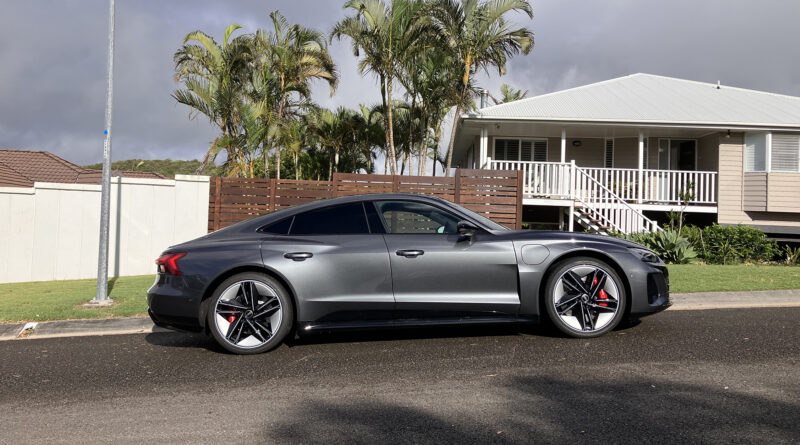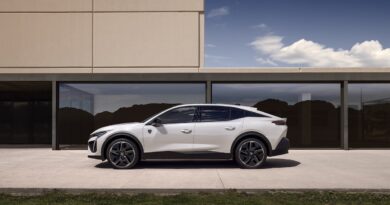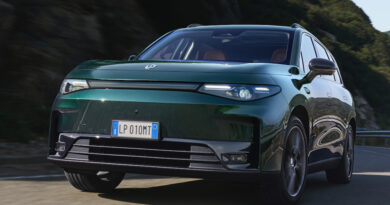Seven-day test: 2024 Audi RS e-tron GT, now with $100,000 price cut?
Times are tough in premium EV world, and you need only scour the classifieds to prove it.
This year we’ve seen prestige EV prices slashed, mainly ex-demo models sitting at dealerships gathering dust rather than buyer interest.
Audi’s ballistic RS e-tron GT is a high-profile example, sitting stubbornly with an RRP of $251,110 while dealers are trying to shift 2023 examples from $179,990 drive-away. Factor in some pretty hefty on-road costs and that’s a haircut of around $100,000.
There are no less than 73 RS e-tron GTs currently offered on carsales.com.au, most with just a few hundred kilometres travelled. Cheapest is at a Tasmanian Audi dealer showing just 495km – it may have only been charged once in its short life.
On Audi’s website it lists ten close to me in Brisbane. I can order from the selection for between $275,000 and $302,000 drive-away. I’d feel a bit of a mug for doing so when a barely sat-in ex-demo’s cheaper by a hundred large.
Complicating matters is Audi last month teasing prototypes of a facelifted 2025 e-tron GT, likely to be spearheaded by a new Performance version based on the ludicrous 815kW/1340Nm Porsche Taycan Turbo GT.
Where would that leave the current crop of tough-to-shift RS e-tron GTs? After seven days living with one, I’d suggest as something of a ballistic, gorgeous EV bargain. Since when was 475kW, 830Nm and 0-100km/h in 3.3 seconds not enough, anyway?
Hate to go all consumer advice on you, but with dozens sat around at dealers, I’d suggest you could put in a cheeky offer on one well below current ex-demo asking prices…
Day 1: Lookin’ good
Don’t get me wrong, I haven’t got six figures to drop on any car, but dammit the RS e-tron GT looks a lot of special car for the money.
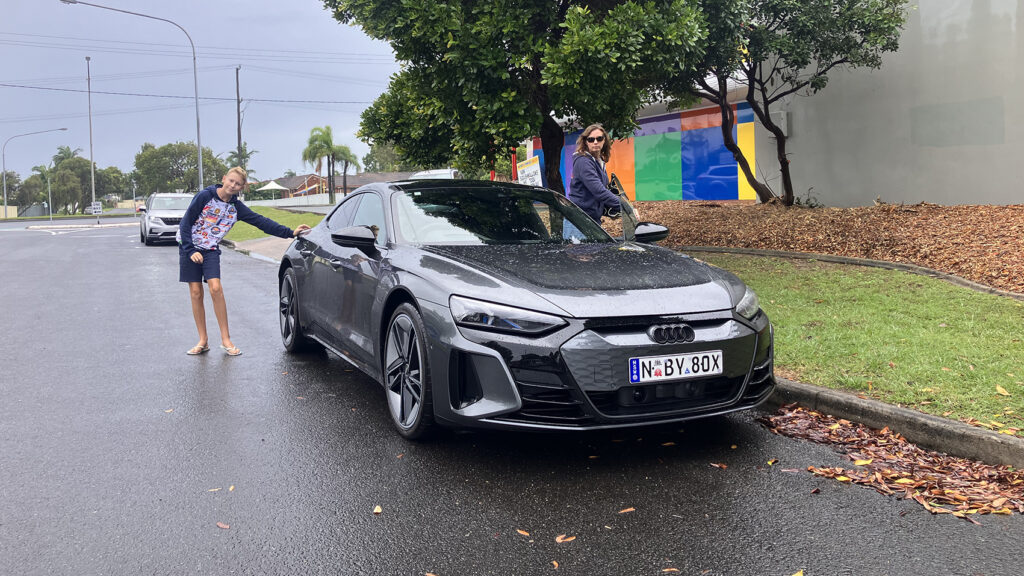
Ours is dressed in mature pearl effect Daytona grey, and its four-door coupe body sits delightfully over 21-inch trapezoid alloys. Thank goodness for the red brake calipers behind to add a dash of colour to the otherwise monochrome German.
The kids love it. The thing just looks fast. The better half has gone all snooty and insists it’s not as attractive as a Porsche Taycan, once I explain this GT shares much of its under-skin with the Stuttgart alternative.
I’m pretty taken with it, especially its back end. So very fat, so low, and the giant full-length light bar and segmented rear clusters play a merry jig when I unlock it. In profile it’s got striking stance – as the kids may say – dropped on its flanks with adaptive air suspension.
And you know what? That RS badge on the rump also still means something special. Be you EV convert or otherwise, there’s the sense anything with that red and black emblem is going to mean a good time.
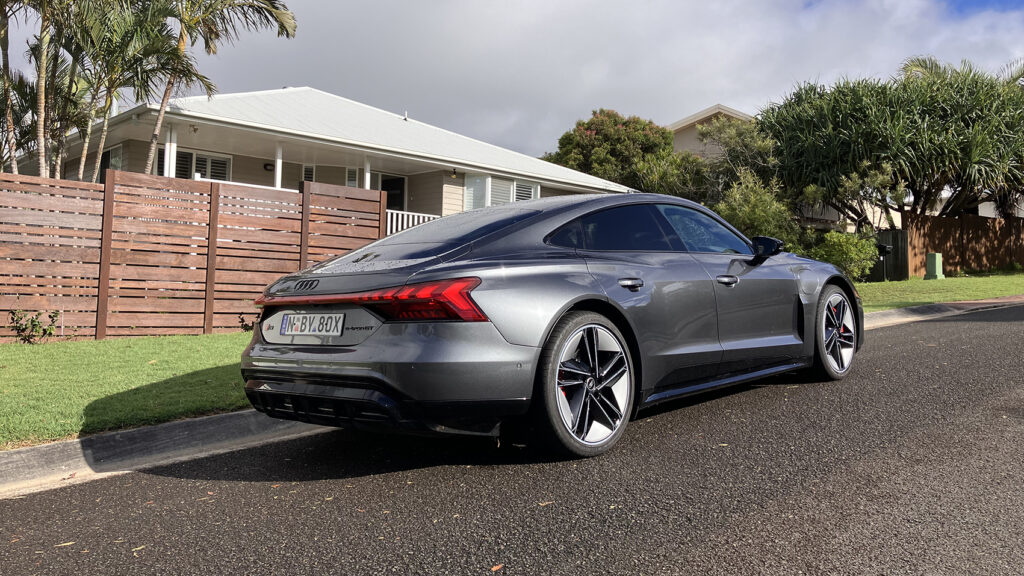
I’m nursing a knee injury so getting into the ultra-low GT’s a bother. Considering the typical buying demographic here (we know you Boomers have all the disposable $$) this is a handy test. In short, there’s no elegant way of getting in and out if you’ve any sort of mobility drama.
Once in the saddle it’s all expectedly divine. Proper bucket-like sport seats are coated in Nappa leather with honeycomb stitching, they adjust a gazillion ways and are heated and ventilated. Bit tight charging another $8400 for a ‘Sensory package’ to bring massage too – a welcome feature on a grand tourer.
The dash layout’s classic sporting Audi, and on first impression the cabin feels less spectacular than a Porsche Taycan’s.
But I prefer it. Instead of the Taycan’s annoying over-reliance on putting everything through a damn screen, the Audi’s more old school analogue buttons and switches make using the climate control refreshingly simple. As it should be.
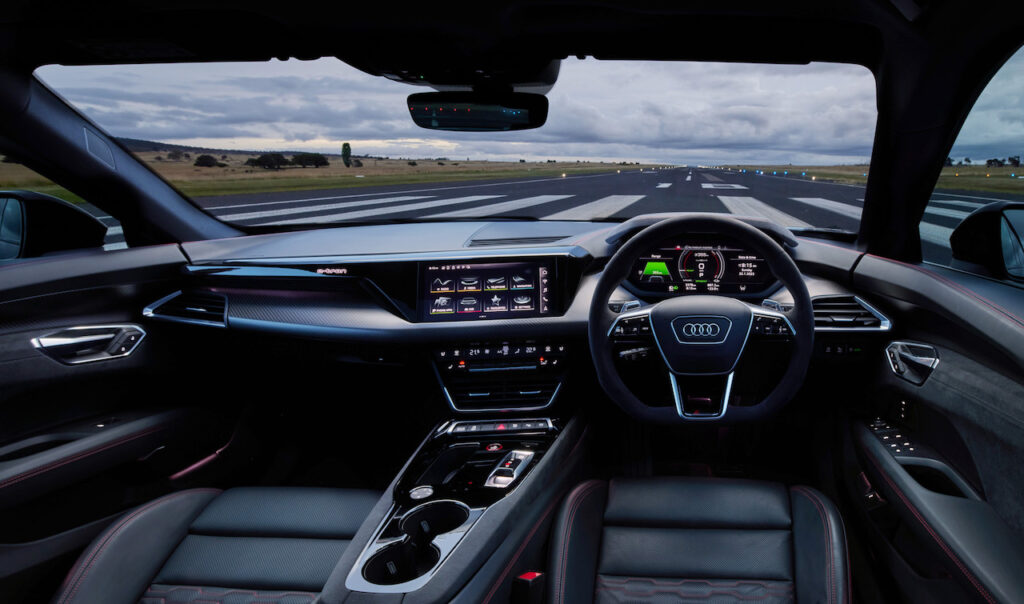
Today’s a transport stage day, getting the GT back home for proper evaluation.
The battery says full, and the dash readout promises 397km range – already 90km down on the official figure. The last driver had clearly been enjoying the performance.
Day 2: Goodbye, driving licence
It’s an early start and I’m greeted with clear skies and dry roads (unlike the rest of the week to come).
Into Dynamic mode, I pull out onto the deserted main road and mash the throttle. The acceleration’s nothing short of violent. It’s a brutal, brilliant experience.
Thrust seems to come in two rapid stages. The first wad of power and torque pins you to your seat, and before you’ve time to breathe, there’s an additional wall of performance arriving like an immediate second helping.
It’s not needed – speed was already building like a tsunami – so this almost turbo-like extra kick up the backside has me near laughing and shouting in equal measure. It’s just so damn bloody mad fast.
Is this almost two-stage acceleration a result of the two-speed transmission – rare indeed for an EV – I wonder? Either way, it’s addictive and unceasingly brilliant.
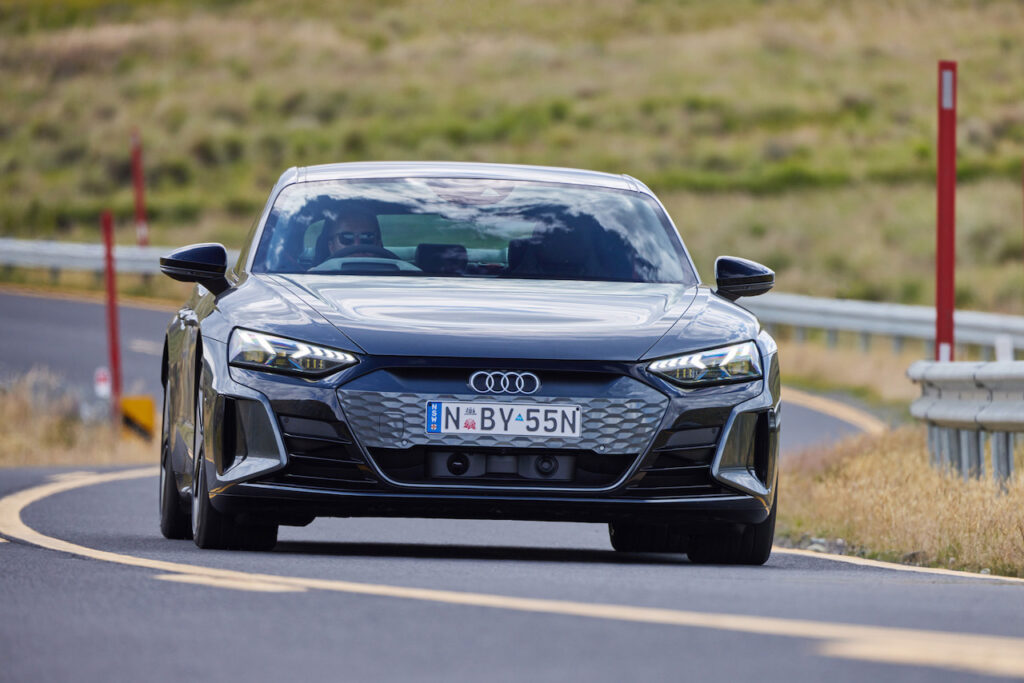
This is before I’ve even tried launch control. This is a 2.5-second boost offering 475kW rather than the normal 440kW.
I use it once from standstill and marvel at the traction and supersonic thrust, but to be honest, I much prefer the rolling acceleration when planting the right foot while already on the move. It feels kinder on the car.
But as I’ve said before with these ballistic EVs, you’re asking for licence trouble. You can perform these acceleration tricks with barely a noise to be heard, and that can catch up on you. In literally a blink you’re over the 60km/h limit and on to seriously large speed numbers before you even realise. Speed cameras will have no sympathy.
Day 3: Family life
Traditional auto gear shifters are on borrowed time, aren’t they? The Audi’s is a little button you pull down with one finger. I suppose it’s better use of space.
There’s decent front cabin storage in this big GT, but after just a few days use I notice how fingerprinty the piano black centre console is. If you have staff, they’ll often be out with the microfibre cloth.
After 300km travelled the consumption average is 20.2kWh per 100km – exactly Audi’s official claim. I decide I could be a full-time tester for the brand. Somewhere in the German mountains over our winter and their summer would be fine.
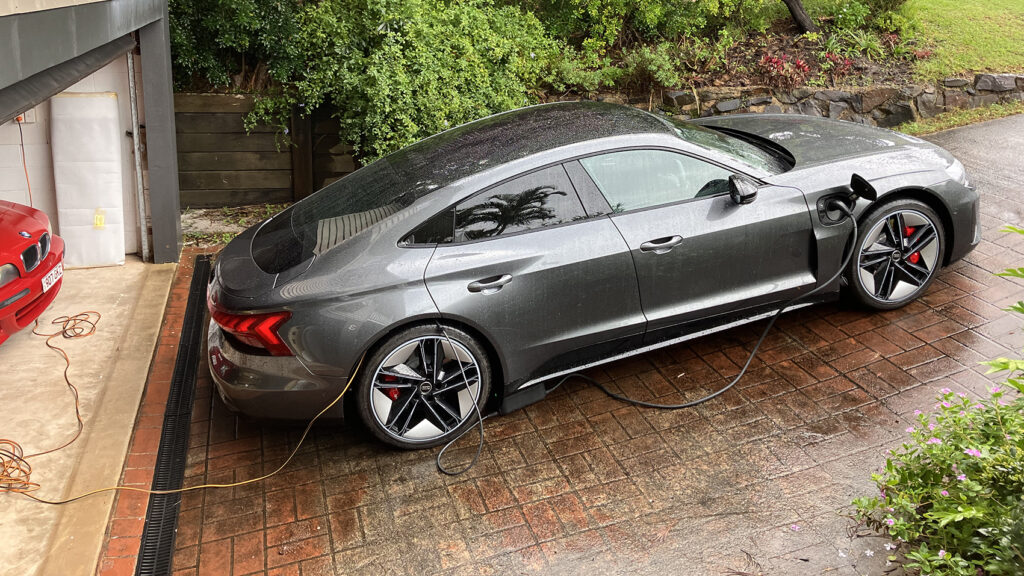
The glass roof bathes the cabin in light, illuminating the carbon fibre weave through the dash and door trims. An e-tron badge lights up and the ambient lighting’s beautiful when night driving.
It’s not exactly roomy in the rear. At six foot my head is on the roof, and skinny windows make it feel claustrophobic.
My two kids (12 and 9) suggest the back seats are too low. I explain they’re bucket seats, holding them well in place while Daddy tackles some tight turns with gusto.
They’ve got their own climate control panel, heated seats and a couple of USB-C ports back there, but as with the Porsche Taycan – if it’s been optioned – the middle rear seat is not a place you want to ride. It’s incredibly skinny.
These GTs are at their best with designer shopping bags or soft leather holdalls on the backs seats, rather than kids. But at least it’s a proper four-door so there’s no awkward clambering in.
The boot’s not a whopper by the way, but at least there’s a frunk to store away your charging cable gubbins.
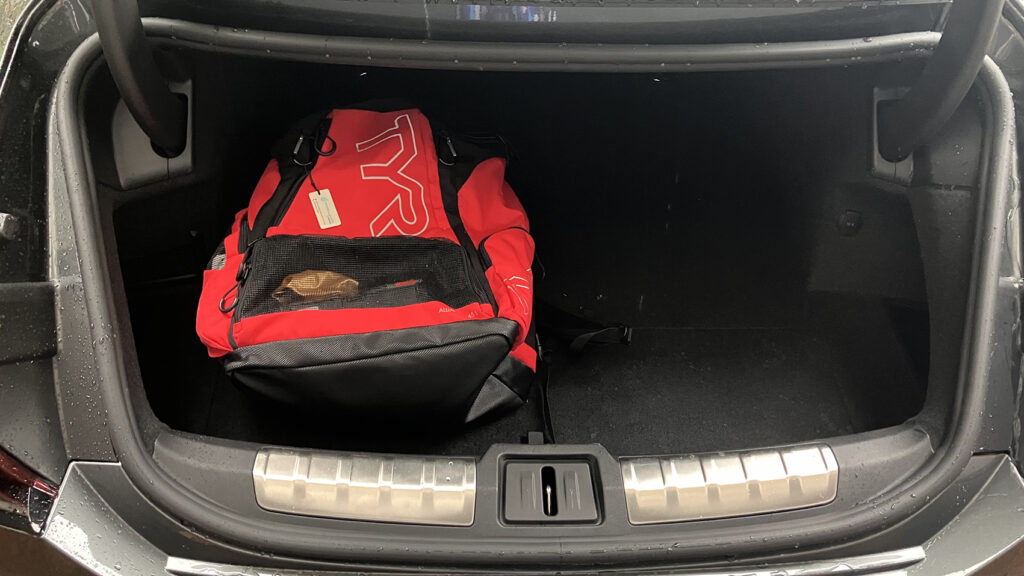
Day 4: On a charge
Consumption is now at 20.5kWh/100km after some highway driving, and it’s time for our first public charging.
A 50kW public one gets my range from 100km to 208km in 28 minutes (23kWh delivered), giving just over 50 per cent full battery.
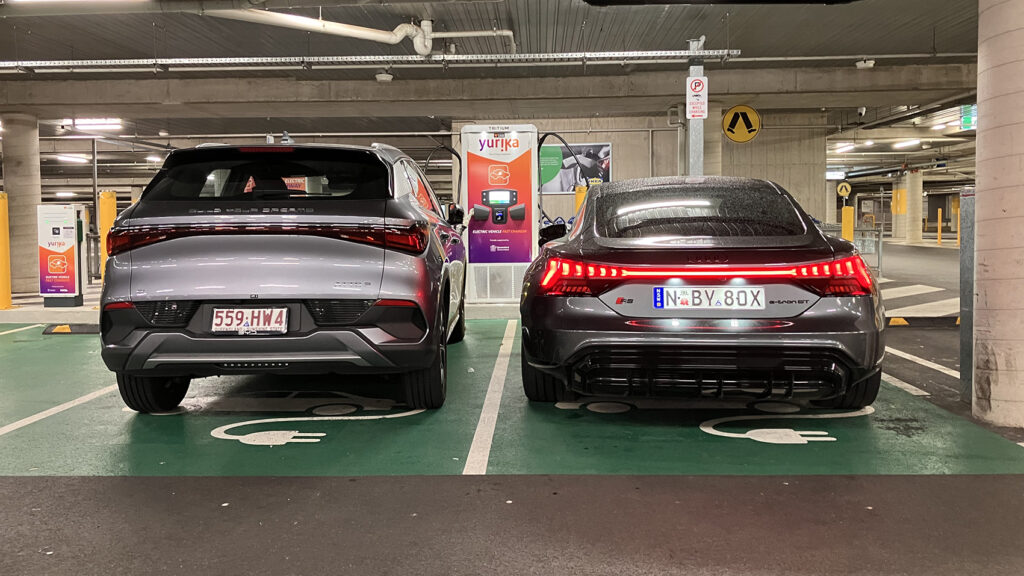
This will get me home where I’ll top it up overnight, but really, this Audi needs a proper ultra rapid public charger to make use of its 800v charging system and 270kW (approx.) max charge speed. Sadly, there’s none near me.
In theory, a 350kW charger would add 100km in five minutes. In 23 mins, the 83.7kWh battery would go from 5-80 percent.
A home charging cable’s provided with the RS e-tron GT (it wants to for $250k before on-roads), but for those without a home wall box, plugging into the home socket delivers electrons at a glacial pace.
On charge overnight I add only another 80km range, working out at about 11 kilometres per hour this way. It’d need roughly 41 hours to go from empty to full using this method. But of course, it’s absolutely fine for topping up.
Word of warning. The DC charge port is on the left and the AC port’s on the right. Easy to get this the wrong way round and look like a mug re-parking the car to charge.
Day 5: Wet roads and quattro
I’m endlessly impressed by how easy this GT is to live with.
Ride comfort is superb despite its sporting bent, and on dry road testing, its handling and excellent grip have made it all too easy and often thrilling.
It’s not exactly nimble – it weighs 2420kg after all – but its just so damn confident, planted and seems happy to point in the right direction no matter the cornering velocity. One squeeze of the right toe and it’s shockingly, brilliantly quick. Just warn your passengers before snapping their necks back.
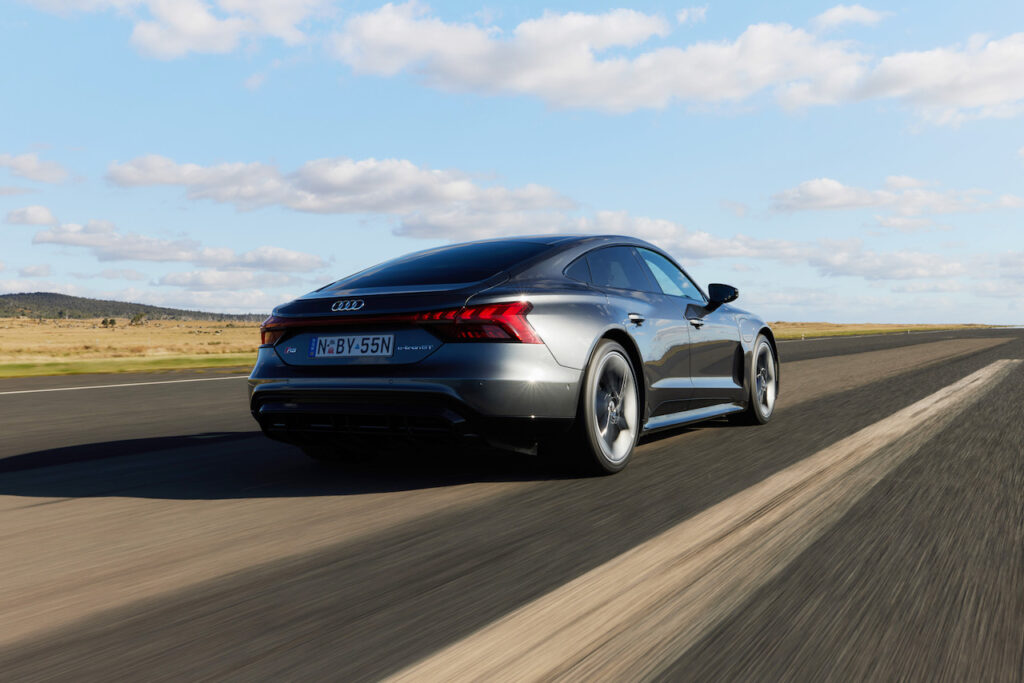
I don’t love the sound. The driver can change the intensity, but it is a bit ‘whooshy.’ Its stablemate Porsche Taycan’s sound isn’t exactly a winner either. I reckon these cars should just embrace their electricness and give silent, rapid progress.
The weekend brings rain. Like proper, monsoon rain.
On wet roundabouts the RS suddenly really feels its true weight. It becomes a carnival of understeer, and I’m conscious not to burn through these giant 21-inch tyres. Replacing the complete set can’t be a fun financial feeling.
The rain stuffs around economy, too. My journey in the wet returns a 23.9kWh/100km average.
Day 6: Charging in a monsoon
I’ve not given enough credit to the sound system. When Audi fits premium audio it’s true concert hall stuff. I’ve questioned why the Q7 SUV’s surround sound option brings a five-figure additional cost, but then I have a listen and fully understand. For audiophiles (Audi-ophiles?) it’s a required indulgence.

The RS has a Bang & Olufsen 3D system as standard, bringing 16 speakers, subwoofer, 15-channel amp and total power of 710 watts. From Bach to Bieber, it delivers sound that has you sticking around in the car at journey’s end, just to complete the song. Okay, maybe not for Bieber.
Dangling carrots with the RS are six years complimentary scheduled servicing, plus six years free public Chargefox charging.
Nothing quite like filling up for free, so I find a Chargefox station (only 50kW sadly), and it reminds me how shitting poor Australia’s charging ‘stations’ really are.
The rain is coming down in sheets, yet there’s zero shelter over the charging station. I commit to charging, scan my Chargefox token and plug in the GT. Of course it has a problem connecting with the car, so we must hook to cable back into the charger and start over.
By this stage I’m already wetter than an otter’s pocket.
I go again, and this time charging begins. But now I’m really sodden and miserable.

After an hour and seven minutes I’ve added only 51kWh and now have 72 per cent battery charge. That’s a long wait, and as the charge station’s only nearby open shop is an Officeworks, I decide it’s a pretty sad way to spend part of your Saturday when you’ve a $250,000 performance weapon at your disposal.
Adding to the misery, how can such an expensive car have such a poor reversing camera? It has no cover, so on a wet day it gets soaked and then steams up, meaning you can’t rely on it when reversing.
My eight-year-old VW Golf has that worked out with the pop-out Volkswagen badge covering the rear camera when it’s not in use. Simples, Audi. Please borrow this trick from your group partner.
Day 7: The $100,000-off question
It’s gorgeous, aggressive, a performance monster and a fabulous GT car with glorious interior.
The RS e-tron GT would be at its most relevant carving across continental Europe with your other half in the low-slung seat beside, but it’s also surprisingly easy to live with in low-speed coastal Queensland.
After 600km at 60km/h average speed, the final energy consumption result is 20.2kWh/100km – not the most efficient of EVs, but incredible German efficiency in nailing the official economy figure.
As a less commonplace alternative to the Porsche Taycan Turbo models, this Audi’s a compelling GT indeed. Sticking point would always be the price, so could you really buy one for $100k under list?
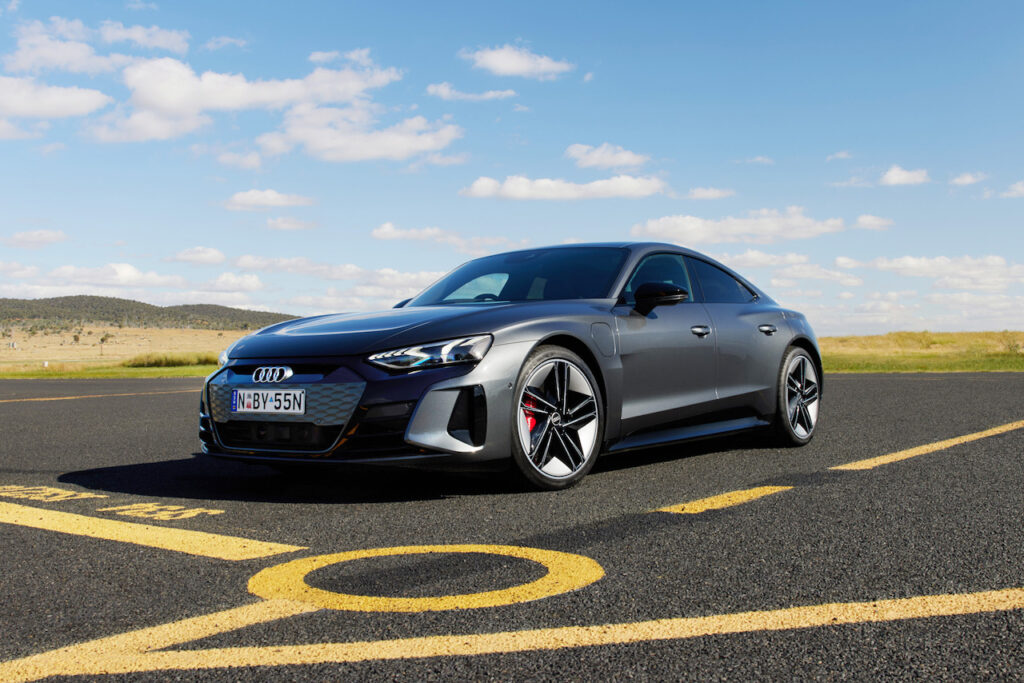
Absolutely you could. There’s a glut of these RS GTs gathering cobwebs at dealerships, and they’ll want rid before the new model arrives.
It’s a special car at any price, but show me another four-door GT at $180,000 drive-away with this kind of cabin luxury, tsunami-like performance and styling that turns every head.
The Porsche Taycan lure may be strong, but you’d be a goose to not test an RS e-tron GT before committing.
Audi RS e-tron GT specifications
Price: $248,200 plus on-road costs
Basics: EV, 5 seats, 5 doors, large hatchback, AWD
Range: 488km (WLTP)
Battery capacity: 83.7kWh
Battery warranty: 8 years/160,000km
Energy consumption: 20.2kWh/100km (20.2kWh/100km as tested – Bingo!)
Motors: One on each axle, combined maximum output 440kW (475kW on boost) / 830Nm
AC charging: 11W, Type 2 plug
DC charging: 270kW (approx), CCS Combo plug
0-100km/h: 3.3 seconds (claimed)

